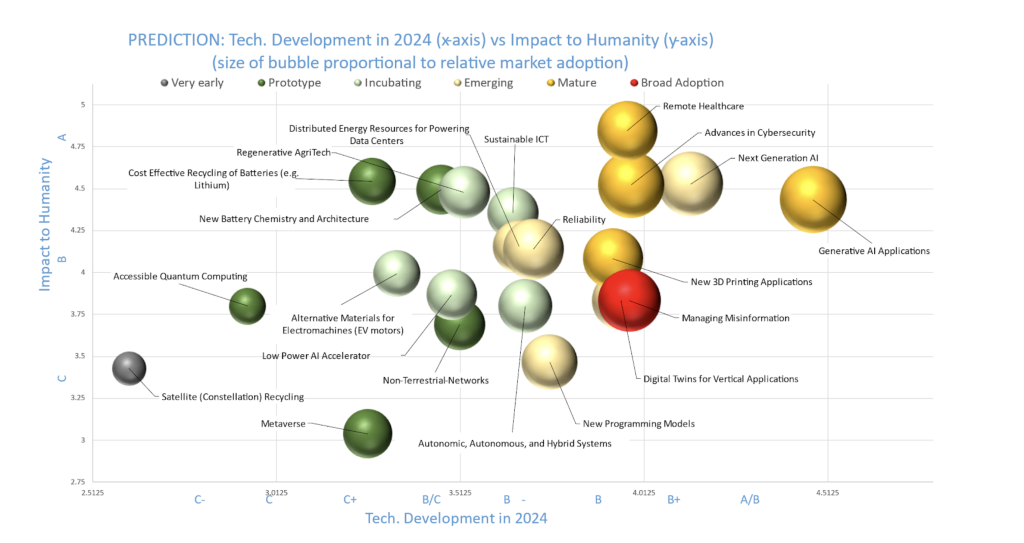 Each January, the IEEE Computer Society releases its Technology Predictions Report to highlight emerging areas to watch and guide technical focus for the year. This report evaluates emerging technologies on a number of criteria, including potential technology development success, impact to humanity, technological maturity, and market adoption. Each technology receives a letter grade using a U.S.-based educational evaluation scale, with A serving as excellent, C as average, and D as low potential in the coming year.
Each January, the IEEE Computer Society releases its Technology Predictions Report to highlight emerging areas to watch and guide technical focus for the year. This report evaluates emerging technologies on a number of criteria, including potential technology development success, impact to humanity, technological maturity, and market adoption. Each technology receives a letter grade using a U.S.-based educational evaluation scale, with A serving as excellent, C as average, and D as low potential in the coming year.
But this is not a predictive exercise alone: The committee reconvenes later in the year to assess the accuracy of their forecasts and determine how they fared against the broader landscape, scoring themselves on how tangible outcomes measured up to expectations. For 2024, the committee just completed this process and delivered an “A” on their personal scorecard of how these predictions fared—one of the highest marks in recent history.
“For 20 of the 21 technologies we called out in our report, predictions varied by less than one standard deviation,” said Dejan Milojicic, 2014 IEEE CS president and current HPE Fellow and VP at Hewlett Packard Labs. “We saw where technologies were heading and accurately pointed out how they would shift and evolve this year.”
Specifically, when looking at each predicted technology across all criteria, they scored as outlined in the charts below. The figures below demonstrate the shift in predictions between the final scorecard and the original report for Technical Success versus Impact to Humanity. The size of the bubble is proportional to relative market adoption. (For a deeper dive into each individual criteria, see the full report.)


Prediction successes
Overall, continued growth in autonomic, autonomous, and hybrid systems, as well as Generative AI applications and artificial general intelligence (AGI) supported the original forecasts in these areas. In fact, autonomic systems scored high across likelihood to technology success, impact to humanity, and market adoption, while artificial general intelligence and Generative AI withstood a drop in expectations in impact humanity, compared to autonomic systems, due to concerns about how beneficial versus detrimental to humanity these technologies could be. In addition, the committee recognized their strongest predictions around new programming models, advances in cybersecurity, regenerative AgriTech, and digital twins for verticals.
“One of the important differentiators of our report is that we look at a broad range of criteria when we assess technologies,” shared Milojicic. “While we see their successes, we also recognize no technology achieves perfection, and our scoring takes into account where there are opportunities for strengthening or mitigating impact.”
Technologies with room for improvement
To that point, technologies represented in the original list also weathered declines. For instance, managing misinformation had a large volatility year-over-year, leading to the largest drop in predictions, which the committee attributes to the volatility of the forthcoming elections around the world and successes and failures in protecting against misinformation around them. In addition, 3D printing fell short of expectations, due in part to the saturation of continuous advancements in previous years. Finally, the metaverse failed to achieve the anticipated amount of technology advancement and market adoption but also boasted an increase in expectations for impact to humanity.
“While these technologies may not have hit the anticipated milestones this year, they remain on our radar for future evaluation. The landscape continues to evolve, and we expect to be addressing these shifts in our 2025 predictions,” summed up Milojicic.
Leading the industry
For over a decade, IEEE CS has been recognized as both a pioneer and leader in providing annual technology predictions. Work has begun to support the development of the 2025 report. Check back for next year’s technology predictions in January 2025.
“Each year the Technology Predictions Report generates deep dialogue and consideration of emerging areas of importance for the global computer science and engineering community,” said Jyotika Athavale, 2024 IEEE CS President. “This report helps to guide our priorities in investing in certain activities and on which we should focus on in a given year; it’s really valuable information. I want to thank the full committee for all of its hard work, and I look forward to our discussions around what’s next for 2025.”
The dedicated volunteers on the 2024 Technology Predictions and Assessments Committee spent countless hours evaluating differing technological solutions and anticipating how they would impact computer science and engineering this year. Participants included: Ali Abedi, Mohamed Amin, Cherif Amirat, 2024 IEEE CS President Jyotika Athavale, Rosa M Badia, Mary Baker, Greg Byrd, Mercy Chelangat, 2024 IEEE President Tom Coughlin, Izzat El Hajj, Paolo Faraboschi, Nicola Ferrier, Eitan Frachtenberg, 2017 IEEE CS President Jean Luc Gaudiot, Ada Gavrilovska, Alfredo Goldman, Vincent Kaabunga, 2018 IEEE CS President Hironori Kasahara, Witold Kinsner, Danny Lange, Phil Laplante, Avi Mendelson, 2019 IEEE CS President Cecilia Metra, 2014 IEEE CS President Dejan Milojicic (chair), Puneet Mishra, Chris Miyachi, Khaled Mokhtar, Chengappa Munjandira, Bob Parro, 2023 IEEE CS President Nita Patel, Alexandra Posoldova, Farzin Shadpour, Marina Ruggieri, Sohaib Qamar Sheikh, Tomy Sebastian, Saurabh Sinha, Vesna Sossi, Luka Strezoski, Vladimir Terzija, Michelle Tubb, Gordana Velikic, John Verboncoeur, Irene Pazos Viana, Jeff Voas, Rod Waterhouse, and Gerd Zellweger.
Please note the views expressed in the report are those of the individuals who participated on the committee, and do not reflect the opinions of their employing organizations.
For more information on IEEE CS’ Annual Technology Predictions, visit computer.org.